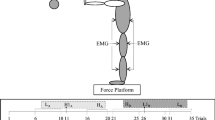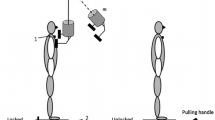Abstract
This study investigated the relation between the magnitude of a motor action triggering a postural perturbation and the magnitude of anticipatory postural adjustments. Subjects stood on a force platform and held, in extended arms, a balloon with a 2.2-kg load suspended on a rigid cord. In different series, unloadings were induced by fast bilateral shoulder abduction movements, by popping the balloon with a tack taped to the subject's right middle finger, or by the experimenter popping the balloon. Anticipatory postural adjustments were seen during all self-initiated unloadings as changes in the level of activation of postural muscles and in displacements of the center of pressure. However, absolute values of these changes were significantly smaller in the series with balloon popping as compared to the series with shoulder abductions. Such reactions were absent when the unloading was triggered by the experimenter. We conclude that a self-triggered perturbation is always associated with anticipatory postural adjustments, while the magnitude of the adjustments may be scaled with respect to the magnitude of a motor action used to induce the perturbation.
Similar content being viewed by others
References
Alekseev MA, Dobronravova IS, Naidel AV, Smetanin BN (1979) On the mechanism of postural adjustment during foot movements (in Russian). Hum Physiol 5: 579–588
Allum JHJ (1983) Organization of stabilizing reflex responses in tibialis anterior muscles following ankle flexion perturbations of standing man. Brain Res 264: 297–301
Aruin AS, Latash ML (1995) Directional specificity of postural muscles in feed-forward postural reactions during fast voluntary arm movements. Exp Brain Res 103: 323–332
Aruin AS, Nicholas JJ, Gottlieb GL, Lee KC, Latash ML (1994) Anticipatory reactions during dropping and catching weights. J Biomech 27: 604
Bazalgette D, Zattara M, Bathien N, Bouisset S, Rondot P (1986) Postural adjustments associated with rapid voluntary arm movements in patients with Parkinson's disease. Adv Neurol 45: 371–374
Belenkiy VY, Gurfinkel VS, Pal'tsev YI (1967) Elements of control of voluntary movements. Biofizika 10: 135–141
Bernstein NA (1967) The co-ordination and regulation of movements. Pergamon, Oxford
Bouisset SM, Zattara M (1981) A sequence of postural movements precedes voluntary movement. Neurosci Lett 22: 263–270
Bouisset S, Zattara M (1990) Segmental movement as a perturbation to balance? Facts and concepts. In: Winters JM, Woo SLY (eds) Multiple muscle systems. Biomechanics and movement organization. Springer, Berlin Heidelberg New York, pp 498–506
Burleigh AL, Horak FB, Malouin F (1994) Modification of postural responses and step initiation: evidence for goal-directed postural interactions. J Neurophysiol 72: 2892–2902
Cordo PJ, Nashner LM (1982) Properties of postural adjustments associated with rapid arm movements. J Neurophysiol 47: 287–302
Crenna P, Frigo C, Massion J, Pedotti A (1987) Forward and backward axial synergies in man. Exp Brain Res 65: 538–548
Dick JPR, Rothwell JC, Berardelli A, Thompson PD, Gioux M, Benecke R, Day BL, Marsden CD (1986) Associated postural adjustments in Parkinson's disease. J Neurol Neurosurg Psychiatr 49: 1378–1385
Dietz V, Mauritz KH, Dichgans J (1980) Body oscillations in balancing due to segmental stretch reflex activity. Exp Brain Res 40: 89–95
Dufosse M, Hugon M, Massion J (1985) Postural forearm changes induced by predictable in time or voluntary triggered unloading in man. Exp Brain Res 60: 330–334
Friedli WG, Cohen L, Hallett M, Stanhope S, Simon SR (1984) Postural adjustments associated with rapid voluntary arm movements. I. Electromyographic data. J Neurol Neurosurg Psychiatr 51: 232–243
Friedli WG, Hallett M, Simon S (1988) Postural adjustments associated with rapid voluntary arm movements. II. Biomechanical data. J Neurol Neurosurg Psychiatr 57: 611–622
Horak FB, Esselman PE, Anderson ME, Lynch MK (1984) The effect of movement velocity, mass displaced and tasks certainty on associated postural adjustments made by normal and hemiplegic individuals. J Neurophysiol 62: 841–853
Lacquaniti F, Maioli C (1989) The role of preparation in tuning anticipatory and reflex responses during catching. J Neurosci 9: 149–159
Latash ML, Aruin AS, Shapiro MB (1995a) The relation between posture and movement: a study of a simple synergy in a twojoint task. Hum Mov Sci 14: 79–110
Latash ML, Aruin AS, Neyman I, Nicholas JJ (1995b) Anticipatory postural adjustments during self-inflicted and predictable perturbations in Parkinson's Disease. J Neurol Neurosurg Psychiatr 58: 326–334
Massion J (1992) Movement, posture and equilibrium: interaction and coordination. Prog Neurobiol 38: 35–56
Melvill-Jones G, Watt DGD (1971a) Observation on the control of stepping and hopping movements in man. J Physiol (Lond) 219: 709–727
Melvill-Jones G, Watt DGD (1971b) Muscular control of landing from unexpected falls in man. J Physiol (Lond) 219: 729–737
Nashner LM, Cordo PJ (1981) Relation of automatic postural responses and reaction-time voluntary movements of human leg muscles. Exp Brain Res 43: 395–405
Nashner LM, Woollacott M (1979) The organization of rapid postural adjustments of standing humans: an experimental-conceptual model. In: Talbott RE, Humphrey DR (eds) Posture and movement. Raven, New York, pp 243–257
Oddsson L, Thorstensson A (1986) Fast voluntary trunk flexion movements in standing: primary movements and associated postural adjustments. Acta Physiol Scand 128: 341–349
Palmer E, Cafarelli E, Ashby P (1994) The processing of human ballistic movement explored by stimulation over the cortex. J Physiol (Lond) 481: 509–520
Paulignan Y, Dufosse M, Hugon M, Massion J (1989) Acquisition of co-ordination between posture and movement in bimanual task. Exp Brain Res 77: 337–348
Riach CL, Hayes KC, Lucy SD (1992) Changes in center of pressure of ground reaction forces prior to rapid arm movement in normal subjects and patients with cerebellar ataxia. Clin Biomech 7: 208–214
Rossignol S (1975) Startle responses recorded in the leg of man. Electroencephalogr Clin Neurophysiol 39: 389–397
Strauss H (1929) Des Zusammenschrechen. J Psychol Neurol (Lpz) 39: 111–231
Struppler A, Gerilovsky L, Jakob C (1993) Self-generated rapid aps directed to the opposite forearm in man: anticipatory reduction in the muscle activity of the target arm. Neurosci Lett 159: 115–118
Viallet F, Massion J, Massarino R, Khalil R (1992) Coordination between posture and movement in a bimanual load lifting task: putative role of a medial frontal region including the supplementary motor area. Exp Brain Res 88: 674–684
Author information
Authors and Affiliations
Rights and permissions
About this article
Cite this article
Aruin, A.S., Latash, M.L. The role of motor action in anticipatory postural adjustments studied with self-induced and externally triggered perturbations. Exp Brain Res 106, 291–300 (1995). https://doi.org/10.1007/BF00241125
Received:
Accepted:
Issue Date:
DOI: https://doi.org/10.1007/BF00241125




